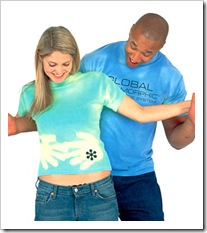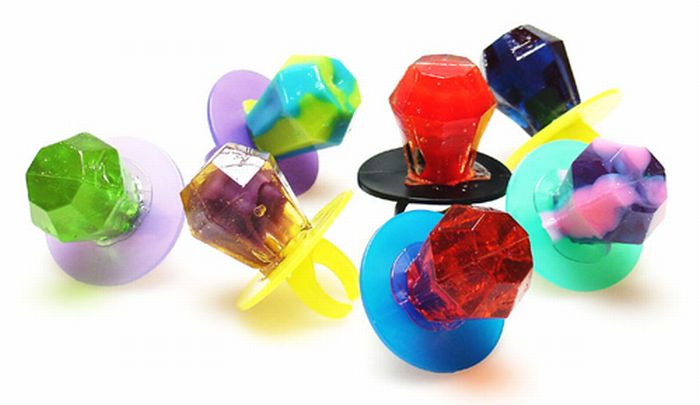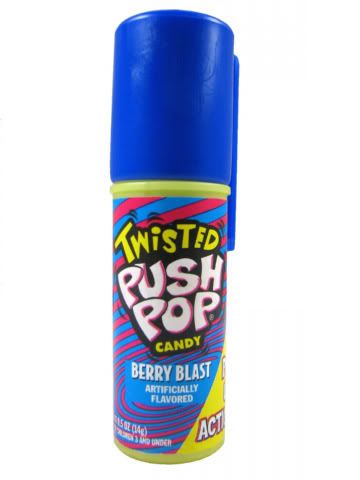
Oh, thermochromic dye. You've been so good to me. I really enjoy the way you point out my topographical sweat and body temperature patterns to everyone within a 2 block radius. Don't even get me started on your uncanny and limitless ability to entertain myself via the imprint of my own hand. Thermochromic dye, you've done us proud.
We all know fashion and function are often mutually exclusive concepts. The basic Maslovian need for clothing to keep us warm and relatively unexposed is pretty far away from the actual items lining department store racks. The aesthetic isn't always our reliable guiding principle. If you grew up in the 80s and 90s, you certainly know that clothing was not meant to be flattering. What, you mean people actually wear clothing to accentuate their finer physical attributes? Don't make me laugh. I'm talking a strict clothing diet of zebra-stripe Zubaz and oversized eye-burningly neon t-shirts and that's that.

Hypercolor was a perfect example of alleged fashion over function. The novelty factor on these items of clothing was high, with the practicality registering remarkably low. Hence the hottest (pun intended) fashion necessity came in the form of a temperature sensitive t-shirt with a remarkable ability to change color. Sounds harmless enough, right? That is, until every soon-to-be-traumatized-for-life kid on the playground learned that sweat is indeed warm. There's nothing quite like a blue shirt with pink armpits to highlight your body's more embarrassing modes of temperature regulation.
Regardless of potentially awkward social scenarios, hypercolor t-shirts were activated by all types of forces, each of which we immediately manipulated upon discovery. All sorts of otherwise unexceptional stimuli--a warm breath, a sweaty palm, the blast of a hair dryer--suddenly morphed into incredible modes of self-entertainment. Not to mention they made great party tricks*.
The dancing in this commercial makes me want to go get a hi-top fade haircut and don some Hammer pants, stat
Novelty clothing like hypercolor has the effect of immediately producing a frenzied response among sheep-like consumers. That is to say, people couldn't wait to get their hands (literally, for its inevitable ensuing color variance) on these t-shirts. Unfortunately for hypercolor producers Generra, these frantic trends tend to fade pretty quickly. In this case, the fade was often literal as hypercolor t-shirts soon hung languidly in our closets, far, far away from the sunlight needed to activate its powers.
 Hypercolor left great temporary evidence on inappropriate gropage. He looks pretty pleased with his results.
Hypercolor left great temporary evidence on inappropriate gropage. He looks pretty pleased with his results.None of us were particularly used to our shirts having their own unique chemical balance that was highly sensitive to outside stimuli. Children were major target demographic for hypercolor, and we all know how careful kids are with their clothing. Considering these t-shirts were prime sportswear options for all sorts of mess-necessitating experiences, our colors were frequently warped through accidental misuse. One minute a kid's drinking a hearty cup of hot cocoa, the next his shirt is permanently splattered from heat damage.
This doesn't even begin to cover the ensuing hypercolor effects found in one of Generra's other significant markets, ravers who would later appear blurrily on Dateline NBC. Though Stone Phillips could blur the ravers' faces out, their shirts had already done the work for him. There's nothing quite as appealing as scoping out potential rave mates as they dance maniacally to European techno, thus soaking their shirts with multicolored sweat. Then again, those kind folks had the glowsticks and ecstasy to distract them, so it may not have been as serious a factor. Bless their hearts.

The washing machine was another veritable adversary of the hypercolor t-shirt. Anyone who's ever done laundry for a child knows the frighteningly unhygienic mountain of germs that awaits with each load. It's only natural to combat this dirtiness with its natural enemy: the hot water setting. Our poor hypercolor shirts walked the laundry plank, blissfully oblivious of the sad fate they would meet in the deadly spin cycle. While they ignorantly assumed they would be unaffected by the harsh inner-washer climate, they soon were unintentionally subjected to permanent damage. You know what thermochromic dye does when it interacts with heat? Changes hues. You know how much heat is in a washing machine set to "hot"? You don't even want to know. The permanently crappy tie-dye-esque resultant t-shirt was evidence enough.
Despite these obstacles, hypercolor enjoyed significant popularity at the height of its color-changing fame. It was a fad at its best; unreliable, unnecessary, and unexplainable. Just as quickly as Generra's innovation had risen to schoolyard fame, it rapidly waned to the unfortunate point at which the company declared bankruptcy. Lucky for us, however, this did not forever close the book on hypercolored garments.**
According to the LA Times, just one year ago hypercolor was slowly creeping its way back into circulation. Who knows? By next summer, it may be everywhere. We can all be grateful they're taking a different approach, like these Puma sneakers. Hipster paradise American Apparel has also taken a wiser route to the now-retro hypercolor t shirt: by referring to it as Thermochromatic. While the word "hyper" appealed to our early 90s raver eurotrash raver mentality, the current technology-crazed generation much prefers technical terms they don't understand. So go forth and enjoy your reinvented thermochromatic t shirt. Just don't forget to slather on the deodorant.
 Next stop on hypercolor's whirlwind comeback world tour: thermochromatic toilet seats. Best way to avoid sitting on a grossly warm recently used toilet seat. Take the plunge into the latest hypercolor technology here
Next stop on hypercolor's whirlwind comeback world tour: thermochromatic toilet seats. Best way to avoid sitting on a grossly warm recently used toilet seat. Take the plunge into the latest hypercolor technology here*For fourth graders, at least
**I know, I sensed your panic there for a second. Don't worry though. Just find your way to an American Apparel and your hypercolor craving symptoms should clear up in 6-10 business days. Or however long it takes you to become an ironic irreverent hipster. Either one.









